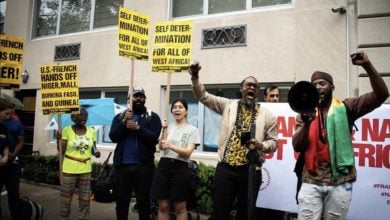Political and military leaders are scrambling to redefine the U.S. occupation of Afghanistan, now in its seventh year, as the situation spirals out of control in the face of a rapidly strengthening insurgency. The primary goal may no longer be securing victory, but rather avoiding a catastrophic, humiliating defeat.
|
The less-than-enthusiastic response from NATO countries was one more blow to the U.S. occupation. Germany pledged the most additional troops in response to Gates’s plea: a mere 600 soldiers. There are 38,000 U.S. troops and 32,000 from other countries in Afghanistan.
Speaking at the end of the session, Gates implicitly acknowledged that significant contributions in combat troops would not be forthcoming. Instead, he called for other governments to support the war effort by sending civilians to carry out so-called development tasks in the country.
The meeting was a diplomatic disappointment for Washington, which had been pressing for a much larger NATO combat role in Afghanistan. Increasingly bold resistance attacks over the last few months have turned up the heat in the country. Hundreds of military vehicles have been burned in attacks, and a crucial bridge in the Khyber Pass supply line was bombed and destroyed. Much of the country is controlled by insurgents, and there have even been coordinated attacks on the capital, Kabul.
The growing resistance is fueled by widespread opposition to the occupation. Attacks by unmanned Predator drones, which may minimize U.S. military casualties, have repeatedly killed civilians. Corruption in the U.S. puppet government is rampant, and large sums of foreign money are being siphoned off to a few privileged elites.
A study prepared by the U.S. Central Command and the International Security Assistance Force has noted a 46 percent increase in civilian casualties in 2008 over the year before. The report, “Metrics Brief, 2007-2008,” makes clear the increased strength of the resistance. Coalition deaths have increased by 35 percent. In the war so far, at least 581 U.S. soldiers have been killed.
During the election campaign, Obama called for about 7,000 additional troops to be sent to Afghanistan. But in the transition period after the election, military leaders began to press for 30,000 additional troops. Obama’s announcement that 17,000 troops would be sent, an implicit acknowledgement that the U.S. military was not winning the war, could be the first in a series of troop level increases aimed at avoiding defeat.
Cutting losses by cutting deals
The administration faces a huge problem in Afghanistan. If it continues to commit more troops, it faces a quagmire. Already analysts are suggesting that Afghanistan, long known as the “graveyard of empires,” may become “Obama’s Vietnam.”
The precarious position of U.S. imperialism goes beyond the Afghani borders. During the election campaign, Obama said the United States should be free to launch Predator drone attacks inside Pakistan, where resistance forces operate freely in key regions. The Pakistani government effectively ceded the Swat valley to resistance forces as part of a ceasefire announced on Feb. 15, further underscoring the shift toward compromise to avert defeat.
Should avoiding defeat take root as Washington’s primary goal in the region, it is likely that more concessions may be on the way. Those could include cutting deals with forces that Washington would not reach out to in the past, including elements of the Taliban. A Feb. 19 New York Times editorial suggested that Iran should also be involved—something that would mark a significant shift in policy toward that country.
The Taliban is a politically reactionary formation. Its top leaders fought in the CIA-backed war against the socialist government that was in power in Afghanistan between 1978 and 1992. Washington provided limited financial support for the Taliban government until the Sept. 11, 2001, attack.
Prior to the attack, Osama Bin Laden had taken refuge in Afghanistan. Washington immediately demanded that the Taliban hand over Bin Laden. The Taliban did not rule that out, but asked the U.S. government for proof that Bin Laden was involved in the Sept. 11 assault. The Bush administration responded by declaring that there would be “no negotiations” and launched a massive bombing campaign and invasion in October 2001. Eighteen months later, it launched an even larger invasion of Iraq.
Having failed to win a decisive victory in Iraq, Washington carried out a “surge” in troop levels and reached out to insurgents and began paying them to stop shooting at U.S. forces. The Obama administration is hoping to pursue a similar strategy with Taliban resistance forces in Afghanistan: commit more U.S. troops while opening a back channel of cooperation and financial assistance with the armed resistance forces. All their talk about defending women’s rights and human rights will be put on the back burner if they can secure a new alliance with sectors of the Taliban.
A catastrophic military defeat would be a huge blow to U.S. imperialism, but victory is not in the cards. A negotiated stalemate in an effort to save face may be Washington’s choice for cutting its losses.





